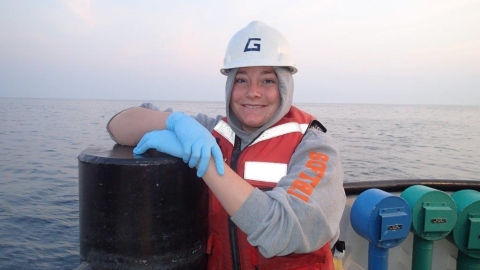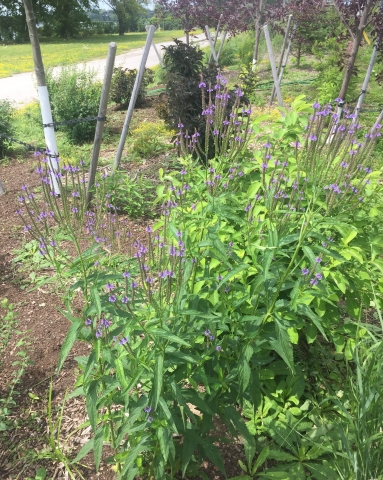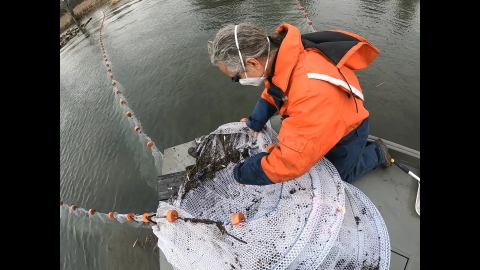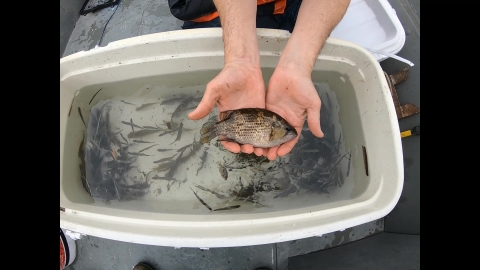
Great Lakes Center Newsletter: Issue 18
June 17, 2021
This issue focuses on a virtual fisheries field trip, planning our summer research, results from two papers on benthos and dreissenid mussels in the Great Lakes, and two of the native plants in the habitat enhancement gardens at the Field Station.
Field Station creates virtual field trip for Fisheries Biology class
by Brian Haas

Common rudd (Scardinius erythrophthalmus) being transferred to the livewell
aboard the electrofishing boat.
The staff at the Field Station usually host a field trip every other spring for the Fisheries Biology class (BIO 429), but due to COVID-19, it was not possible to take the students out onto the water this year. Instead, the Field Station staff created a video using Go-Pro cameras to provide the students with a virtual field trip. The video introduced them to fish sampling techniques that are commonly used in fisheries management and showed these techniques being performed in our local waterways. The final product was streamed to the class through Blackboard and will also be used to support upcoming education and outreach objectives.
The new skills developed through this process will certainly have applications moving forward at the Field Station. Even without COVID-19, it can be difficult to get groups of students out onto the water because of weather, boat capacity, and numerous other factors. The Go-Pro cameras and editing software allow for the Field Station staff to create and share content with students who otherwise would not have been able to accompany the staff as they work to complete research projects. These new tools can now be used to offer even more opportunities to enrich the student education experience at Buffalo State College by providing digital content that is exciting and informative.
More still images from the field trip video in Fisheries techniques video stills.
Planning summer 2021 benthic surveys in Lakes Michigan and Superior
by Allison Hrycik

The Great Lakes Center hosted a virtual planning meeting on March 25–26th for two Cooperative Science and Monitoring Initiative (CSMI) benthos cruises that will occur this year. We will travel to Lake Michigan in July and Lake Superior in September. Only one CSMI cruise would occur in a typical year, but COVID-19 restrictions prevented Lake Michigan sampling from happening last year and we are excited to tackle two lakes in 2021! Sampling includes collection of benthic invertebrates, water chemistry, physical variables like lake temperature and oxygen, and video imagery of Dreissena. This year’s sampling will be a valuable addition to long-term benthos monitoring data sets in Lake Michigan and Lake Superior. We plan to sample 100 stations on Lake Michigan and 72 stations on Lake Superior.
Meeting participants from the GLC were Allison Hrycik, Sasha Karatayev, Lyuba Burlakova, and Susan Daniel. Our collaborators from Cornell and EPA that will be integral to the sampling attended as well. We also heard proposals from several institutions about additional research projects. Researchers from Wright State University are interested in examining benthic algal assemblages, while Cornell researchers are interested in mapping distributions of benthic zooplankton, including benthic cladocerans and harpacticoid copepods. NOAA researchers are looking into Dreissena length-weight regressions, body conditions, and reproductive status. A project to look at daily migrations of the macroinvertebrate Mysis is underway by researchers at Cornell University and the University of Vermont. Proposed food web studies include fatty acid analysis of the amphipod Diporeia by Krasnoyarsk University and stable isotope analysis of food web components by researchers at the University of Wyoming and NOAA. Together, these projects will give us insight into how the components of the benthic food webs of the Great Lakes fit together. We look forward to new collaborations and to seeing how these projects progress!
Campus Notes
Susan Dickinson attended the final School of Natural and Social Sciences (SNSS) Faculty/Staff meeting in the Classroom Building on Friday, May 21st. The meeting, open to all SNSS faculty and staff including members of the Great Lakes Center, featured a slide show with pictures of SNSS staff and faculty throughout the years, and the symbolic act of removing the SNSS banner and Dean’s office signs by Interim Dean M. Scott Goodman (in picture). Beginning June 1st, the SNSS joined with the School of Arts and Humanities to form the School of Arts and Sciences under leadership of Dean Brian Cronk.
Congratulations to Susan Daniel for being elected to the Board of Directors for the International Association for Great Lakes Research (IAGLR). Susan will serve as a U.S. Regular Member for 2021–2024.

former SNSS office.

Long-term benthic data revealed large changes in Lake Ontario ecosystem
by Lyuba Burlakova and Sasha Karatayev

The Laurentian Great Lakes have experienced multiple anthropogenic changes in the past century, including cultural eutrophication, phosphorus abatement initiatives, and the introduction of invasive species. The furthest downstream in the Great Lakes system, Lake Ontario is among the most impaired. Benthos is the diverse community of bottom dwelling invertebrates important as fish food and water quality indicators. The Lake Ontario benthos has been studied intensively in the last six decades and provided valuable insights into the impact of environmental changes over time.
In 2018, the Great Lakes Center, in collaboration with the US EPA’s Great Lakes National Program Office, collected lake-wide benthic data within the Cooperative Science and Monitoring Initiative and Long-term Monitoring programs. In addition, we compiled all the lake-wide studies of benthic invertebrates over the last 54 years and compared them to our data to assess the major drivers of long-term changes in benthos. We found that the benthic community of Lake Ontario underwent significant transformations that correspond with three major periods. The first period, pre/early Dreissena period (1964–1990), was characterized by high densities of mysis (Diporeia spp.), fingernail clams (Sphaeriidae), and oligochaetes worms (Tubificidae). The same groups were prevalent during the next period of zebra mussel dominance (in the 1990s). The most recent period of quagga mussel dominance (2000s to present) is characterized by the shift of the bulk of mussels deeper into the lake causing dramatic changes in the community, including the near-complete disappearance of Diporeia and Sphaeriidae and the increase in abundance of quagga mussels and oligochaetes. Therefore, the Lake Ontario benthic community, which was historically dominated by Diporeia, Oligochaeta, and Sphaeriidae, has changed to a community dominated by quagga mussels and Oligochaeta. Dreissenids, especially the quagga mussel, were the major drivers of these changes.
The resulting research paper, “Six decades of Lake Ontario ecological history according to benthos,” is published online in Journal of Great Lakes Research.
Graph description: The density of five major benthic groups in Lake Ontario in 1964–2018: Dreissena polymorpha, Dreissena rostriformis bugensis, Diporeia spp. (mysis), Oligochaeta (tubificid worms), and Sphaeriidae (fingernail clams). The graph is additive, showing the density of each taxa stacked on the others. The three study periods are also delineated: Pre/early Dreissena from 1964–1990, Zebra mussel (D. polymorpha) dominance (1990–2000), and Quagga mussel (D. r. bugensis) dominance (2000–2018). Four notable events are included: the Great Lakes Water Quality Agreement, followed by de-eutrophication, in 1970; Lake trout stocking increased, in 1980; Dreissena introduction, in 1990; and Round goby introduction, in 2000.
Lake morphometry determines Dreissena invasion dynamics
by Sasha Karatayev and Lyuba Burlakova

from video footage.
Zebra and quagga mussels, the invasive dreissenid bivalves, are considered the most aggressive invaders in freshwaters. They have become major drivers of ecosystem processes and one of the primary regulators of phosphorus cycling in the Laurentian Great Lakes since the early 1990s. To predict the ecosystem effects of invasive species and to develop the best management strategies, we need to understand their current and future population dynamics and factors regulating their population growth. For the first time, we combined all lake-wide studies of Dreissena since their initial invasion to the Great Lakes and found that invasion dynamics are largely governed by lake morphometry, or the shape and structure of a lake. Where both species are present, quagga mussels generally become dominant in 8–13 years. Thereafter, zebra mussels remain common in shallow lakes, where lake-wide Dreissena density may stabilize. In contrast, in deep lakes, the invasion of quagga mussels leads to a near-complete displacement of zebra mussels, followed by a dramatic increase in overall dreissenid density.
In shallow lakes and in nearshore zones of deep lakes, dreissenids reach maximum density soon after their initial colonization, then decline. In the intermediate zones of deep lakes (30–50 m), Dreissena densities increase more slowly, peak later, and subsequently decline from their maximum levels to a lesser extent. In the deepest zone (>90 m), quagga mussel density and biomass continue to increase, and the lake-wide population shifts toward deeper areas, revealing a potentially strong offshore carbon and phosphorus sink.
The resulting research paper “Lake morphometry determines Dreissena invasion dynamics” is published online with @SpringerNature in Biological Invasions.

rostriformis bugensis).
Habitat planting feature: Blue vervain and cardinal flower
by Kit Hastings

habitat gardens.
As summer approaches, let’s take a look at two of the bright flowers planted at the Field Station as habitat enhancements: blue vervain (Verbena hastata) and cardinal flower (Lobelia cardinalis). Both attract pollinators with their vibrant tube-shaped flowers. They are both commonly found in wet areas or along waterways, and though the parent plants are short-lived perennials, they readily self-seed.
Blue vervain, also known as blue verbena or swamp verbena, grows well in meadows or wetlands. In late summer, it blooms with a ring of small tube-shaped blue or purple flowers in flower spikes arranged like a candelabra, blooming from the bottom of each inflorescence upward. The flowers attract bees, wasps, flies, and butterflies and the seeds are eaten by songbirds such as cardinals, sparrows, and juncos. It is the larval host for the Common Buckeye butterfly (Junonia coenia). Blue vervain and its European cousin vervain (Verbena officinalis) have been used medicinally for a variety of purposes in traditional medicine, although blue vervain does interfere with some Western medicines like blood pressure medication and hormone treatments so it should be treated with caution. Blue vervain is a good addition to pollinator and rain gardens and is a native replacement for invasive plants like purple loosestrife (Lythrum salicaria), European wand loosestrife (Lythrum virgatum), and purple foxglove (Digitalis purpurea).
Cardinal flower is a bright red flower that grows in wetlands, wet meadows and woods, and areas along the water’s edge. A single flower spike that may be several feet tall blooms from the bottom up. Each flower is trumpet-shaped with two upper petals and three fused lower petals. The bright red color is attractive to hummingbirds and some butterflies, and the plant relies mainly on the ruby-throated hummingbird (Archilochus colubris) for pollination. The stamens are fused into a tube above the flower opening, and when a hummingbird visits the flower, the stamens brush on the bird’s forehead. The shape of the flower is difficult to navigate for most insect pollinators, but some bees steal nectar by perforating the lower part of the flower. Cardinal flower is toxic to humans and can cause contact dermatitis, but despite this it has been used medicinally by Native Americans. Over-picking and habitat loss have led to cardinal flower being listed as an “exploitably vulnerable native plant” in New York. This means that it is prohibited to pick, damage, or remove cardinal flower from private property or state-owned land (without permission of the owner). Cardinal flower is a lovely addition to pollinator and rain gardens and is a native replacement for aggressive plants like Canna lilies, Crocosmia, and Gladiolus, some cultivars of which can be invasive under certain conditions.
As you’re planning your gardens this summer, consider planting native plants like blue vervain and cardinal flower to attract pollinators when they bloom later this summer.

Fisheries techniques video stills

Niagara River.

portion of the field trip.

Niagara River. Note the GoPro mounted to his head strap.

